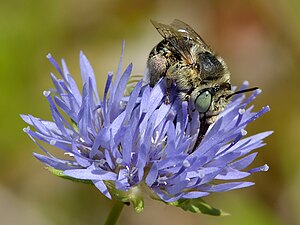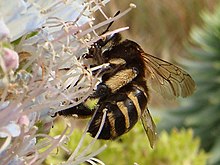Anthophora bimaculata
| Anthophora bimaculata | ||||||||||||
|---|---|---|---|---|---|---|---|---|---|---|---|---|

Anthophora bimaculata |
||||||||||||
| Systematics | ||||||||||||
|
||||||||||||
| Scientific name | ||||||||||||
| Anthophora bimaculata | ||||||||||||
| ( Panzer , 1798) |
Anthophora bimaculata is abeefrom thefamilyofApidae. They are also called dunefur beesin German.
features
The bees are 8 to 9 millimeters long. The females have yellow markings on their faces and yellow-brown, rapidly fading hair. This is mixed with black hair on the vertex and the dorsal thorax . The Tergites two to five have applied Filzhaare and at the rear edge a fitting hair tie. The splint brush (Scopa) is white. The males have a yellow face. The thorax is dorsally brown-red, the head and the first two tergites are hairy yellow-brown. The tergites three to five are hairy black. The tergites have whitish hair ties on the rear edge. The heel phalanx (metatarsus) of the middle legs has white hair fringes on the rear edge. The seventh tergite has a longitudinal keel in the middle and is deeply notched at the end.
Occurrence and way of life
The species is common in southern and central Europe. Rare in Germany, occurs in inland dunes and drifted sand fields, sand pits and ruderal areas. It flies from early July to late August. The females create their nests in the sandy soil, in vegetation-free flat areas or in small edges. Pollen is collected from different plant families. The cuckoo bee of the species is Ammobates punctatus .
supporting documents
Felix Amiet, M. Herrmann, A. Müller, R. Neumeyer: Fauna Helvetica 20: Apidae 5 . Center Suisse de Cartographie de la Faune, 2007, ISBN 978-2-88414-032-4 .
